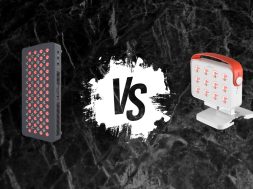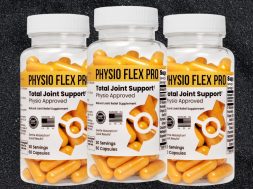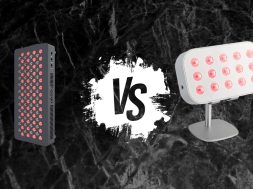
Among the flood of red light at-home devices, the Novaalab Light Pad and the Hooga Red Light Therapy Belt stand out for their balance of performance, practicality, and price.
Both deliver the clinically validated 660nm red and 850nm near-infrared wavelengths shown to reduce inflammation and boost tissue repair.
Yet, they approach recovery from very different angles: Novaalab leans toward versatility and broader coverage, while Hooga focuses on targeted, hands-free convenience.
As a strength coach and grappler who trains several times a week while juggling family life, recovery tools have become non-negotiable for me.
I’ve tested both of these devices at separate times, integrating them into my real training routine to see how they actually perform when you’re sore, busy, and need results that fit real life.
Here’s how the Novaalab Light Pad stacks up against the Hooga Belt in design, effectiveness, and overall value, and which one I’d recommend depending on your recovery goals.
| Feature | Winner |
|---|---|
| Performance & Effectiveness | Novaalab |
| Wavelengths | Draw |
| Design & Build Quality | Novaalab |
| Ease of Use | Hooga |
| Battery | Hooga |
| User Reviews | Draw |
| Price | Hooga |
Quick Verdict
The Hooga Red Light Therapy Belt is the simpler, more portable choice. It’s battery-powered, lightweight, and easy to wear hands-free while doing other tasks.
For localized soreness, especially in the knees, lower back, or shoulders, it does its job well. The downside is that it’s limited in coverage, intensity control, and long-term durability of the straps.
The Novaalab Light Pad, on the other hand, offers broader coverage, higher output, and more control through adjustable frequency settings.
While it’s not wireless, it feels more like a full recovery tool than a quick-fix gadget. The light distribution is even, the warmth penetrates deeper, and it’s more adaptable to multiple body areas.
If you’re looking for a more powerful and versatile red-light therapy device that can cover larger areas and handle serious recovery work, Novaalab Light Pad is the better buy.
What Is the Novaalab Light Pad?
The Novaalab Light Pad is a flexible red-light therapy panel designed for targeted recovery at home. It combines 660nm red light and 850nm near-infrared light to help reduce inflammation, relieve pain, and accelerate tissue healing.
Unlike rigid light panels that require you to stand still in front of them, the Novaalab pad wraps around the body using adjustable Velcro straps.
This makes it suitable for treating areas like the knees, lower back, shoulders, or hamstrings, providing a wide coverage area while keeping the light close to the skin for optimal absorption.
At roughly 15.7″ x 9″, it’s compact enough for home use but large enough to cover multiple joints or a significant muscle group.
The pad includes both steady and pulsed light modes (1–999 Hz), allowing some customization in how the light energy is delivered, which is a feature rarely found in devices at this price point.
From a usability standpoint, the Novaalab Light Pad strikes a good balance between accessibility and performance. You don’t need an app, Bluetooth, or advanced setup, just plug it in, strap it on, and choose your preferred mode.
The corded design limits mobility somewhat, but it ensures consistent power delivery and eliminates battery concerns.
What makes it stand out in practice is its even light output and effective warmth. During my testing, it consistently delivered a soothing heat that penetrated deeper than expected, easing post-training soreness without feeling overly hot or uncomfortable. It’s not flashy, but it’s the kind of tool that becomes a quiet staple in a recovery routine.
You can read my Novaalab review for my experience using this red light therapy device.
Pros
- Dual 660nm red and 850nm near-infrared wavelengths for deep-tissue recovery
- Large, flexible pad for versatile use on multiple body areas
- Adjustable pulsed and steady light modes (1–999 Hz)
- Even light distribution and consistent output
- Effective for muscle soreness, joint pain, and chronic stiffness
- Simple setup, no app required
- Reasonably priced in the mid-range ($300–$400)
Cons
- Corded design limits true portability
- Controller feels plasticky compared to premium units
- Velcro straps may wear over time
- No wireless or app integration
- Warranty could be longer (2 years standard)
What Is the Hooga Red Light Therapy Belt?
The Hooga Red Light Therapy Belt takes a different approach to recovery. Instead of a larger pad or stationary panel, it’s a portable, battery-powered belt that wraps around specific areas for hands-free treatment.
It uses the same proven 660nm red and 850nm near-infrared wavelengths as the Novaalab pad, but focuses on targeted application and convenience.
The design is compact and user-friendly. It’s a soft, flexible belt with a built-in LED panel that contours to your body. You simply charge it via USB-C (it takes about 2–3 hours), strap it on, and hit the single power button.
Each session runs automatically for 20 minutes, providing gentle warmth that promotes circulation and helps loosen stiff or sore areas.
In real-world use, the Hooga shines through its simplicity. There are no intensity settings, apps, or cables to manage. It’s light enough to wear while doing chores, working, or winding down after training, and it delivers measurable relief after consistent use.
During my testing phase, I often used it on my lower back and knees after weightlifting sessions, or on my shoulders following grappling practices. The warmth was steady, soothing, and effective without being overwhelming.
Build quality is solid for its price point. The stitching and LED integration feel durable, and the battery easily lasts for several days of use (roughly 4–6 sessions per charge).
The main wear point over time is the Velcro straps, which begin to fray with heavy use, though they still hold well.
Compared to stationary devices, the Hooga’s main limitation is the coverage area. This means it’s ideal for localized relief but less practical if you want to treat larger zones like the entire back or both legs.
It also lacks customization options found in higher-end models. Still, for under $300, it’s one of the most accessible and genuinely useful red-light therapy tools for athletes and active individuals.
You can read my Hooga review for my experience using this red light therapy device.
Pros
- Clinically proven 660nm + 850nm wavelengths for recovery and pain relief
- Lightweight and fully portable — no cords, hands-free use
- Simple one-button operation with automatic 20-minute sessions
- Durable, flexible design that fits most body areas
- Battery lasts 4–6 sessions per charge (USB-C rechargeable)
- Affordable at $299
Cons
- No adjustable intensity or pulse modes
- Limited coverage area for larger muscle groups
- Velcro straps may wear with frequent use
- Generates noticeable warmth during long sessions
- No app integration or session tracking
Novaalab vs Hooga: Main Differences
Performance and Effectiveness
In terms of pure recovery performance, the Novaalab Light Pad provides broader coverage and a stronger, more even output, making it better suited for post-lifting soreness and overall recovery sessions.
During my month-long testing period, I consistently noticed reduced stiffness in my knees and lower back after using it for 20-minute sessions following heavy squats or deadlifts.
The results weren’t dramatic overnight, but the cumulative effect over a few weeks was clear: less soreness, faster morning mobility, and an overall smoother recovery rhythm.
The Hooga Belt, meanwhile, focuses on targeted, practical therapy. It doesn’t match Novaalab’s coverage or output strength, but it’s far easier to use daily because it’s wireless and hands-free.
I could strap it on while prepping dinner, answering emails, or playing with my kids, something I couldn’t do with the corded Novaalab. After several weeks, the belt noticeably reduced my lower-back tension and knee discomfort from grappling.
If you’re chasing consistent, full-area recovery, the Novaalab wins.
If you’re after on-the-go relief for specific joints or muscles, the Hooga feels more natural to integrate into daily life.
Wavelengths
Both devices rely on the gold-standard wavelengths in red light therapy — 660nm red light and 850nm near-infrared light — but how they deliver that light makes a difference.
The Hooga Belt outputs both wavelengths simultaneously at a fixed intensity. The red light supports skin health and surface-level inflammation, while the near-infrared penetrates deeper tissues to stimulate mitochondrial energy production and enhance muscle and joint recovery.
This simple dual-wavelength setup works well, but lacks adjustability. You get one consistent mode every time you press start, which suits most users but limits fine-tuning for different recovery goals.
The Novaalab Light Pad, on the other hand, allows frequency customization between 1–999 Hz, meaning you can choose between steady or pulsed light delivery.
While I didn’t find massive performance differences between settings, the flexibility itself makes the device more versatile. It lets you experiment with how your body responds to different pulse rates, something advanced users may appreciate.
Additionally, the Novaalab’s larger LED array ensures more even light distribution across the treatment area. When used on the knees, for example, it covered the entire joint and surrounding tissue, while the Hooga required repositioning to hit the same area fully.
Both use clinically validated wavelengths, but Novaalab provides more control and broader, deeper coverage, while Hooga focuses on simplicity and targeted comfort.
Design and Build Quality
The Novaalab Light Pad feels like a professional recovery tool rather than a lifestyle gadget. The flexible silicone body wraps comfortably around the knees, back, or shoulders, and the evenly spaced LEDs deliver uniform coverage without hotspots. It’s sturdy and clearly built for regular use, though not particularly sleek.
The only weak link is the functional but plasticky controller and the Velcro straps, which may lose grip with heavy use. Still, after a month of testing, there were no signs of flicker, overheating, or hardware issues.
The Hooga Belt is designed for portability and comfort. It’s lightweight, under a pound, and the soft fabric exterior feels good against the skin. The LED panel bends naturally with your body, which makes it great for multitasking or light movement during sessions.
The stitching and build feel solid, though the Velcro started fraying slightly after a few weeks of daily use. It also runs noticeably warm, which can have a soothing effect for sore muscles, but is less ideal in the hot Texas weather.
Ease of Use
The Hooga Belt is built for simplicity with a true one-button operation. Strap it on, press start, and it runs for 20 minutes before shutting off automatically.
There’s no setup, no cables, and no settings to fuss with. I often used it while stretching, cooking, or working on my laptop. That kind of convenience makes it easy to stay consistent, even on busy days.
The Novaalab Light Pad, on the other hand, requires a bit more intention. It’s corded, so you’ll need to stay near an outlet, and you’ll spend a minute adjusting the straps and selecting a mode.
But it offers more control, and the larger surface area means you can treat multiple joints or muscles at once. Once set up, it’s completely hands-free and stable throughout the session.
Battery Life and Hardware
The Hooga Belt delivers 4–6 sessions per charge, which works out to several days of use before recharging. The battery indicator is reliable, and charging via USB-C takes just a couple of hours.
The wireless setup gives it a big edge in flexibility as you can use it anywhere, anytime. The LED panel feels durable, though the fabric around the battery housing could use extra reinforcement for long-term wear.
The Novaalab Light Pad is corded, which limits mobility but ensures consistent output and no battery degradation over time. It runs cool and steady even during 30-minute sessions, and the power adapter stays safe to the touch.
I would’ve liked a longer cord and stronger strain relief where it connects to the pad, but overall the hardware feels solid and dependable.
Price
| Device | Type | Wavelengths | Price (USD) |
| Novaalab Light Pad | Flexible corded pad | 660 nm red + 850 nm NIR | $300–$400 |
| Hooga Red Light Therapy Belt | Wearable battery-powered belt | 660 nm red + 850 nm NIR | $299 |
Both devices fall into the mid-range of the red light therapy market, being affordable enough for serious home users but still a step above budget gadgets.
The Hooga Belt offers strong value for its portability and wireless convenience at $299.
The Novaalab Light Pad costs a bit more depending on configuration, but it justifies that with higher output, more coverage, and adjustable modes.
My Experience With Novaalab and Hooga
I tested both devices during different training cycles, not side by side, but as part of my ongoing recovery routine between weightlifting and grappling sessions. Each played a distinct role in how I managed soreness, stiffness, and general recovery.
When I tested the Novaalab Light Pad, my focus was on post-lifting recovery. I used it 4–5 times per week for about a month, typically after squat or deadlift days.
My setup was simple: 20-minute sessions on the knees or lower back while winding down at night. After the first week, the difference in next-day stiffness was noticeable.
It didn’t erase soreness completely, but my joints felt looser and recovery between heavy sessions was faster. The heat felt deep and consistent, and over a few weeks, that cumulative effect added up.
For lingering issues like lower back tightness, the results were subtler but still meaningful. I often used it before bed, and by morning the stiffness was reduced enough to start training without discomfort.
The only drawback was mobility as the cord sometimes got in the way, but overall, it became a dependable part of my recovery routine.
I tested the Hooga Red Light Therapy Belt later, during a period when I was grappling more frequently. The portability is something I was missing with Novaalab, and Hooga brought back.
I could strap it around my knees or back, hit the power button, and keep working, stretching, or even prepping meals.
The warmth was gentler than Novaalab’s but still effective, especially for muscle fatigue and smaller joints. I used it almost daily for about three weeks, mostly after training or in the evening when the soreness from rolling kicked in.
After several days, I noticed faster relief from knee tightness and lower-back soreness. It didn’t have the same depth of effect as the Novaalab pad, but the ease of use meant I stayed consistent. The main downside was the Velcro, which started to fray by the end of testing, though it still held fine.
Should You Buy Novaalab or Hooga?
Choosing between the Novaalab Light Pad and the Hooga Red Light Therapy Belt comes down to how you want red light therapy to fit into your daily life.
If you value convenience and simplicity, the Hooga Belt is the easier choice. It’s wireless, portable, and genuinely effortless to use. You can wear it while doing chores, working, or watching TV, and still get meaningful relief for sore joints or tight muscles.
For most active people who just want a quick, practical recovery aid, it’s hard to go wrong. Its main weaknesses is the smaller coverage and no intensity control, which are acceptable trade-offs for the freedom it offers.
The Novaalab Light Pad, though, is the better option if you want more complete, performance-focused recovery. It’s more powerful, offers customizable settings, and covers a much larger area.
The difference shows over time: deeper warmth, more consistent results, and broader applications for multiple muscle groups. It’s not as convenient, and you’ll be tethered to an outlet, but for athletes or anyone with recurring soreness, that trade-off is worth it.
Novaalab Deep Healing Pad
Novaalab Deep Healing Pad
Powerful red light therapy device designed be applied without having to sit in front of a large light panel.
CHECK CURRENT DEALS











